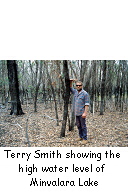
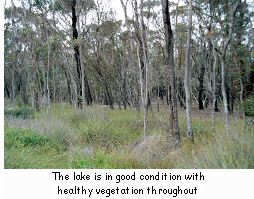 Background
Background
The farming entities of Peter and Allanah Smith and Terry Smith own the properties on either side of Minvalara Lake and Peter and Terry have lived there all their lives. The original owner lived close to the water within the wetland in a 'humpy' and had a well next to the water's edge. Terry's father bought the land in 1967.
The wetland was fenced soon after the time of clearing in the 1960s and is a good example of a wetland that has been protected from grazing for 30 years. Peter thought that his father fenced the swamp early on because of the difficulty in finding stock in the large expanse of bush. "I know he got caught, there was a fence either side and he presumed that it went through the swamp but it never did. He put sheep out there and they walked around the fence and off they went. Dad decided to fence off because he couldn't find the stock in there. While there was water in there they'd go into the water and when he wanted to find them he couldn't get in".
The wetland is an ephemeral yate swamp that covers approximately 280 hectares. It is dry on average about one year in three, although after a wet year it fills to a depth of two metres and will hold water for three or four years. Sand ridges occur on the eastern side and parts of the southern side of the swamp. One feeder gully that has been vegetated for ten years runs into the swamp and the swamp never overflows.
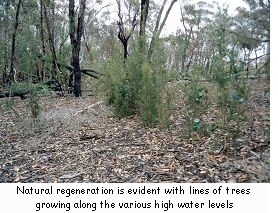 At present it is in good condition with healthy yate and melaleuca trees throughout. Natural regeneration is evident with lines of trees growing along the various high water levels. A fenced 20 hectare buffer of mallee vegetation occurs on all corners of the swamp, which helps to protect it from weed invasion and fertiliser run-off. Terry sometimes pumps water out of the swamp for stock drinking.
At present it is in good condition with healthy yate and melaleuca trees throughout. Natural regeneration is evident with lines of trees growing along the various high water levels. A fenced 20 hectare buffer of mallee vegetation occurs on all corners of the swamp, which helps to protect it from weed invasion and fertiliser run-off. Terry sometimes pumps water out of the swamp for stock drinking.
Peter is now involved with the Devil's Swamp Catchment Group. The group has sourced funding to fence and replant the feeder creek of the wetland and also to carry out monitoring of ground water in the area.
The Threats
Peter and Terry have noticed little change in the vegetation or water quality of the swamp over the years and they believe that the biggest threat to the wetland is the quarantined kochia patch at the top of the catchment.
An 80 hectare area has been sprayed each year for the past seven years to eradicate the declared weed and consequently the ground is bare and they believe that there's "more water coming down than there than used to, it's more of a gut feeling rather than any evidence. Its amazing how quick that bare area up on top runs water".
They are also worried about rising water tables and to assist with water management Agriculture Western Australia is monitoring piezometers across the whole Devil's Swamp Catchment. The open water in the wetland is not readily observable but a flight over the lake in June 1999 showed that an algal bloom was in progress.
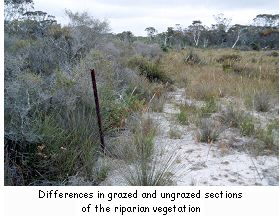 The Solution (a start)
The Solution (a start)
During 1998 the catchment group obtained a grant and a total of 140 hectares of trees were planted in the catchment. Peter says that this has been an aid but it hasn't fixed the whole problem.
"This catchment that comes down here is over the rise from Devils Creek, that's where it starts. I think there's seven or eight farms that drain down this way. We haven't had any kochia on here because most of the drainage system is cleared. The only place where it's steep is through our place where there's an actual gully. The rest of the area has all been cleared and worked through. I think people are starting to realise now that more water is coming down and they've given up working through it but a fair whack of it's been treed in with that grant. But there are still patches that haven't been treed in because people had a dam there and couldn't afford to fence the paddock in half because they had no water in the other half. Hopefully they're still aiming at doing it because the grant was a good kick start".
The Smiths fenced more remnant vegetation in a corner of the swamp in 1994 to protect the trees that were declining in health due to grazing. The difference between the ungrazed and grazed sections can be seen in the photo. This area may be used occasionally in the future for sheep shelter after shearing in cold weather.
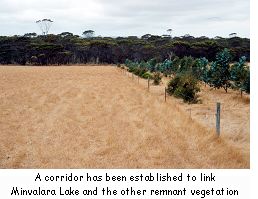 The Observations
The Observations
Terry likes to see all the trees regenerating after fencing and has protected other remnant patches on his farm for this reason. He has fenced off Devil's Creek and has protected 200 hectares of remnant bush along the creek. He has also established a corridor linking remnant bush on this farm to Minvalara Lake.
Of Minvalara Lake he says, "I don't think it's changed much. As long as it doesn't go all salty on us we'll be happy. I don't know why some people didn't realise something was happening years ago and started doing things".
From a farming perspective Terry has found that "in the canola we grow at the moment there is a disease called black leg. If you can have your crops at a distance away from one another from year to year you are better off. Having the bush in between the crops is a benefit".
The Smiths have no plans to use the swamp for any type of production because "it's not full of water the whole time and you can't farm anything in it. We'd just like to keep it fresh, it just depends what happens further up the catchment".
Minvalara Lake Catchment Statistics
| Catchment area: | 8000 hectares | |
| Type of wetland: | Ephemeral lake | |
| Average rainfall: | 525 mm./year | |
| Water quality: | fresh | |
| Catchment disturbances: | Stock grazing, cropping, quarantined sprayed weed area on adjoining farm |





